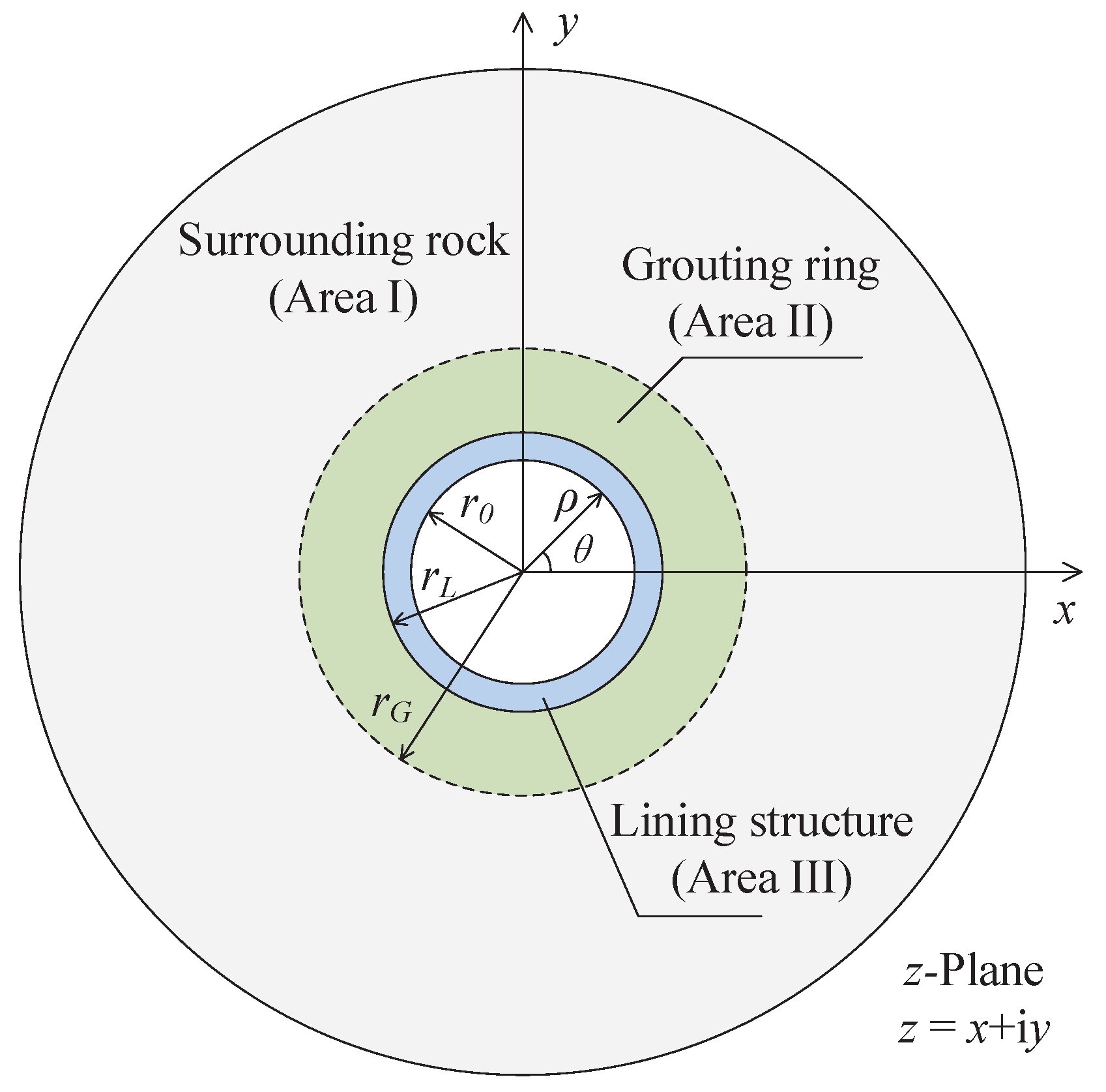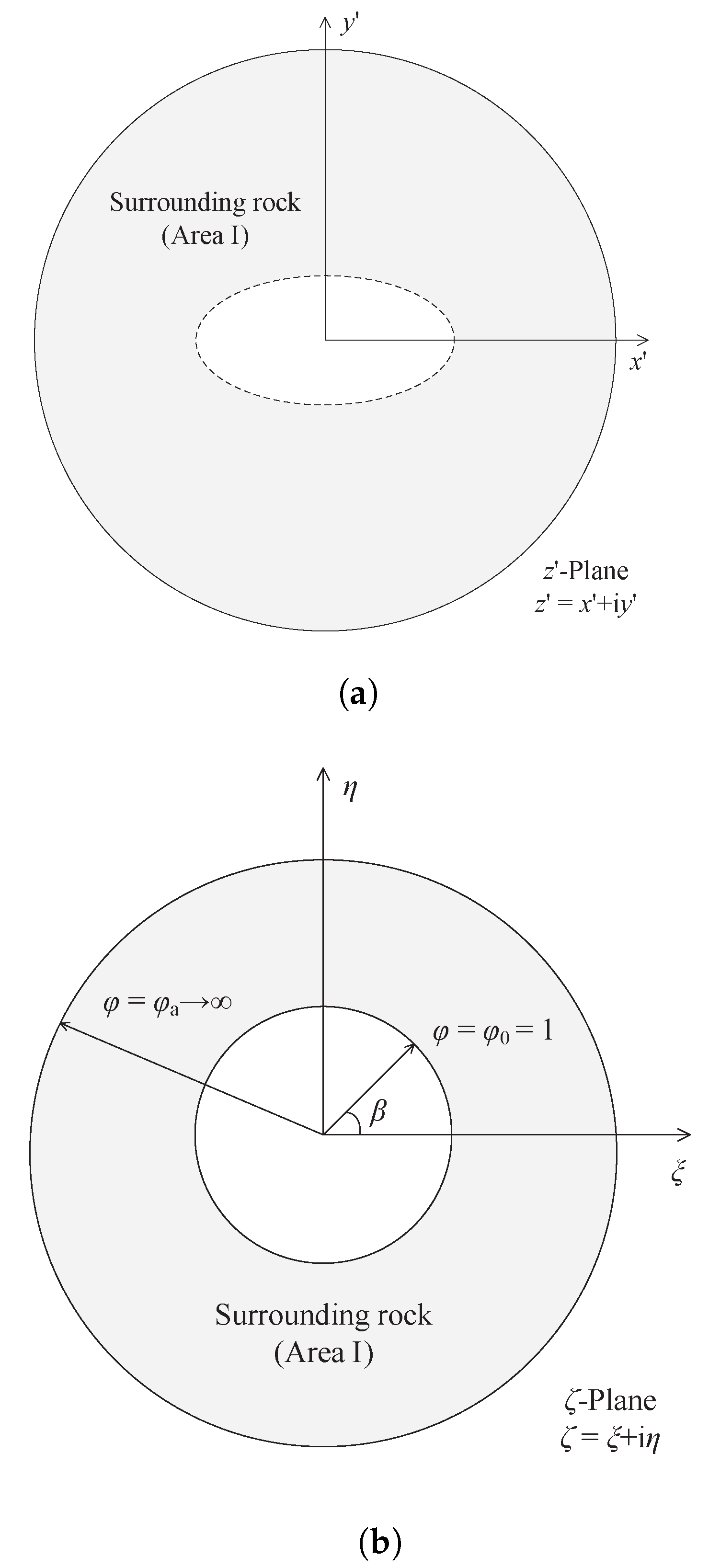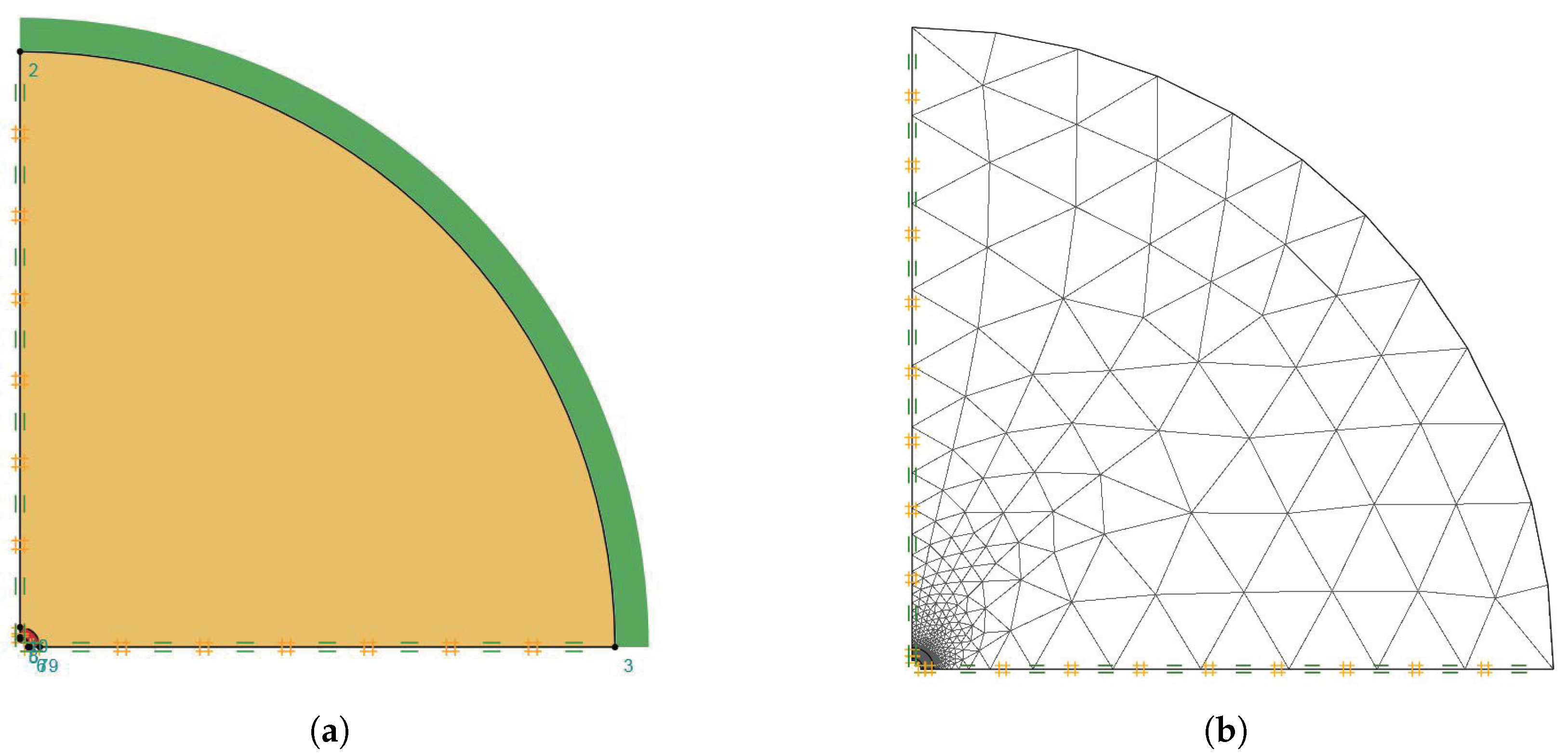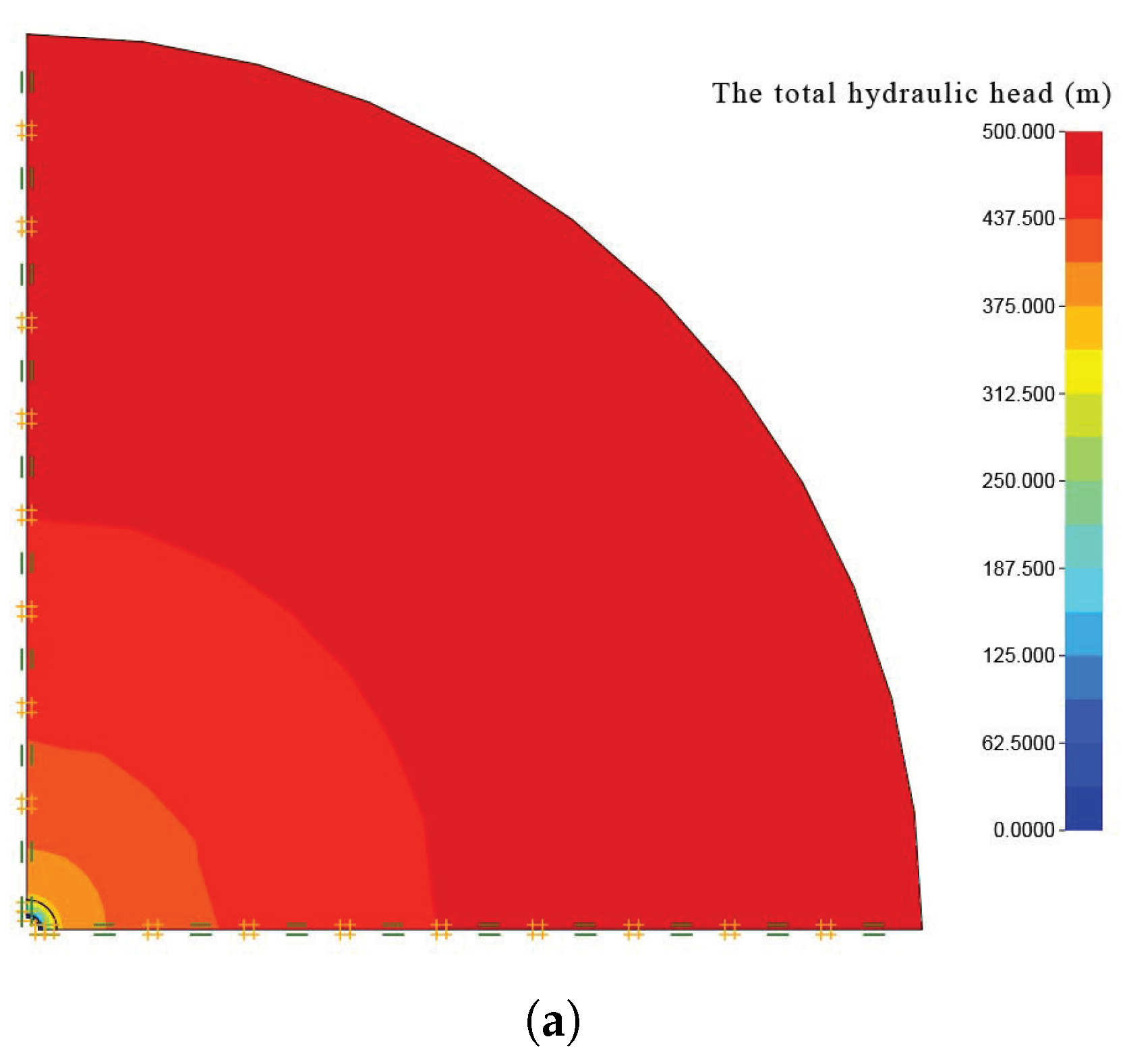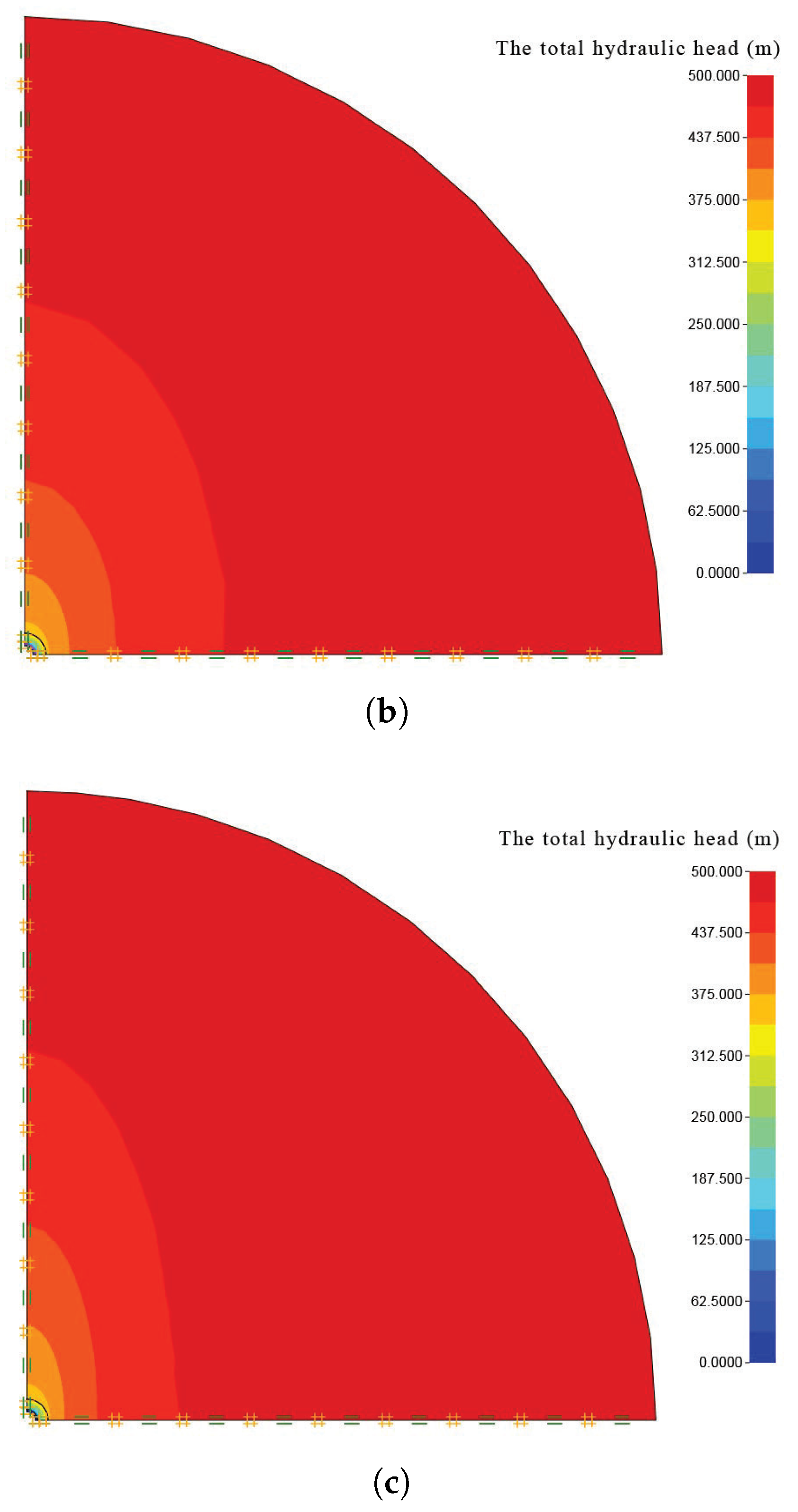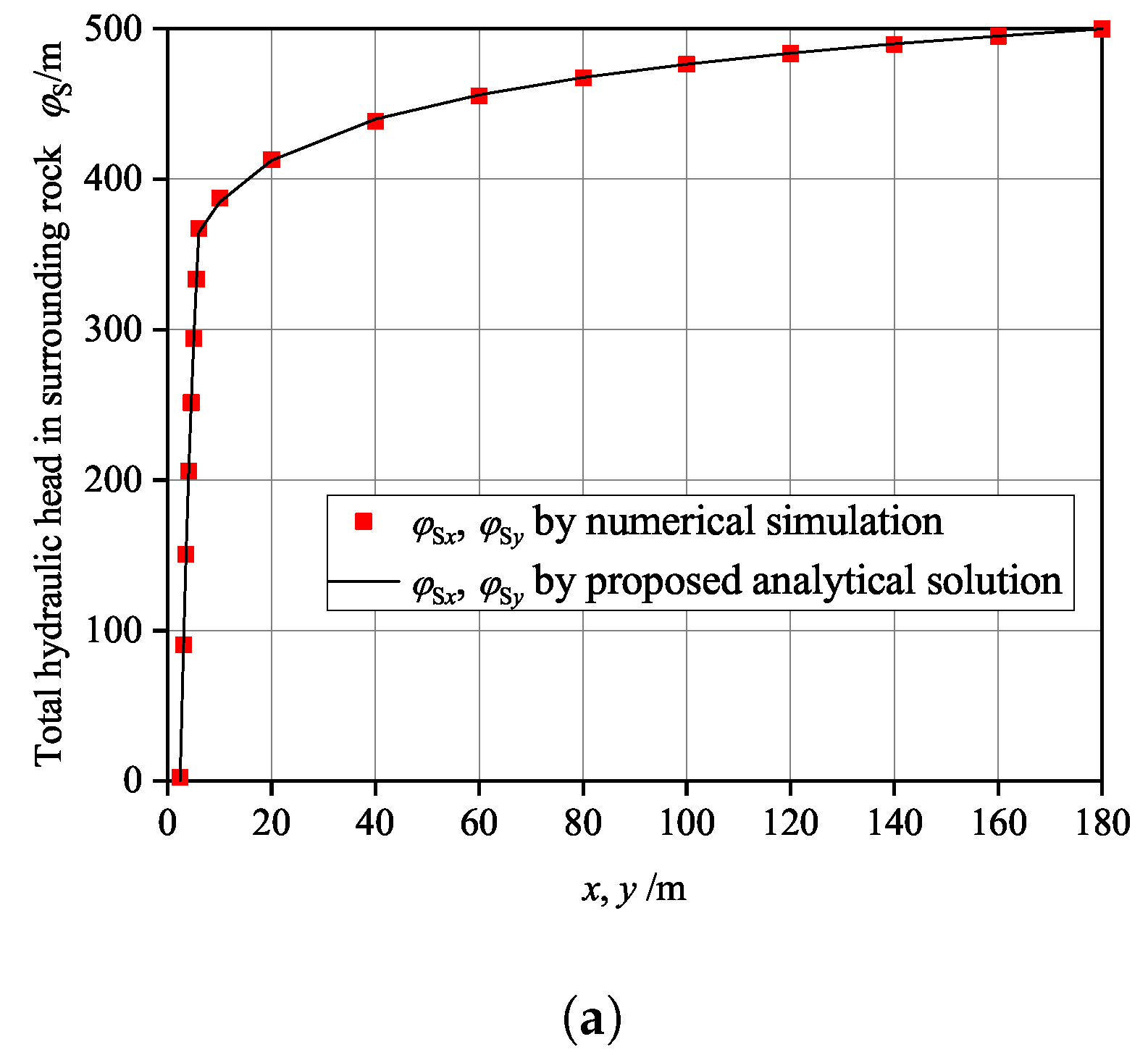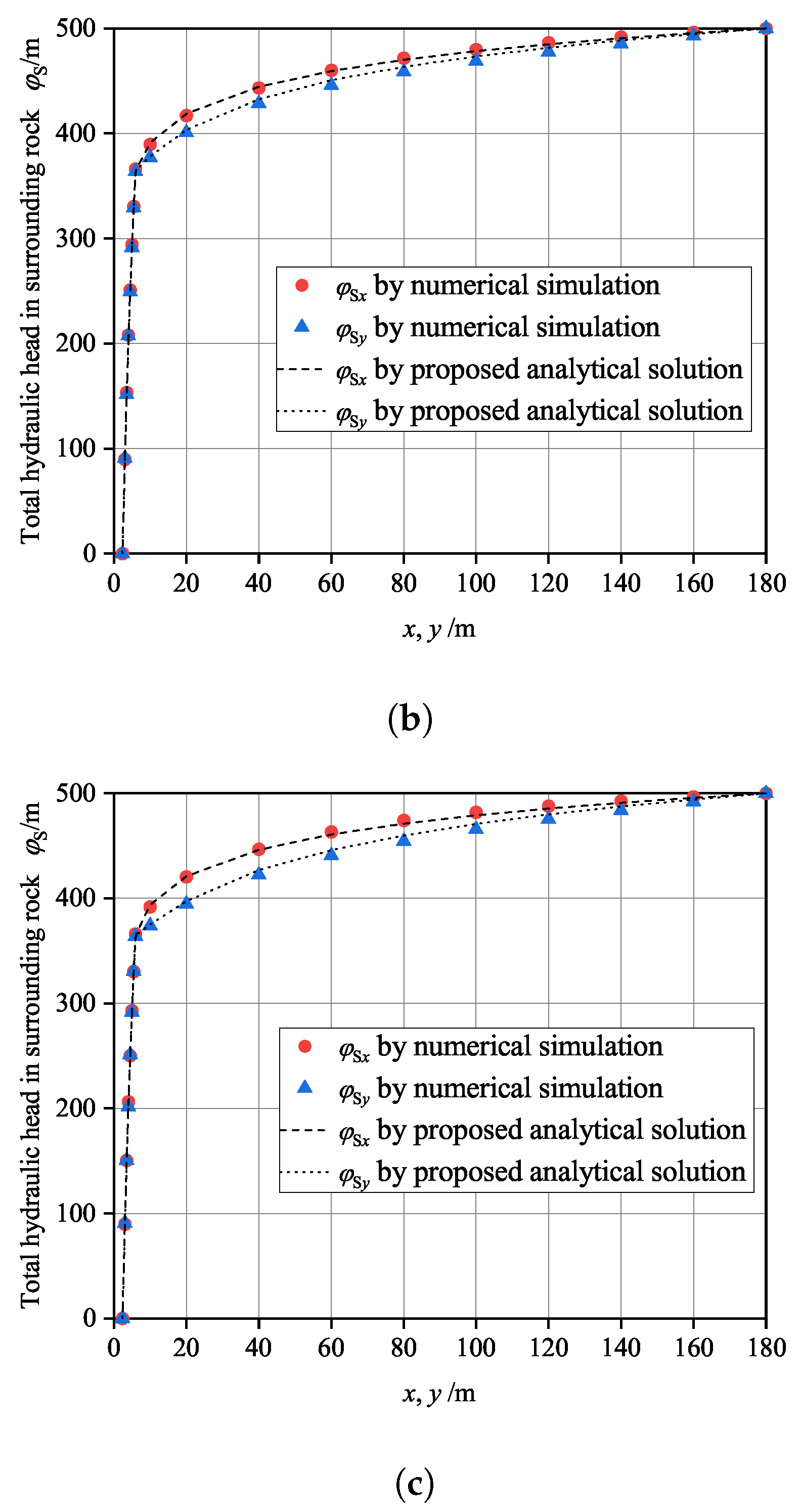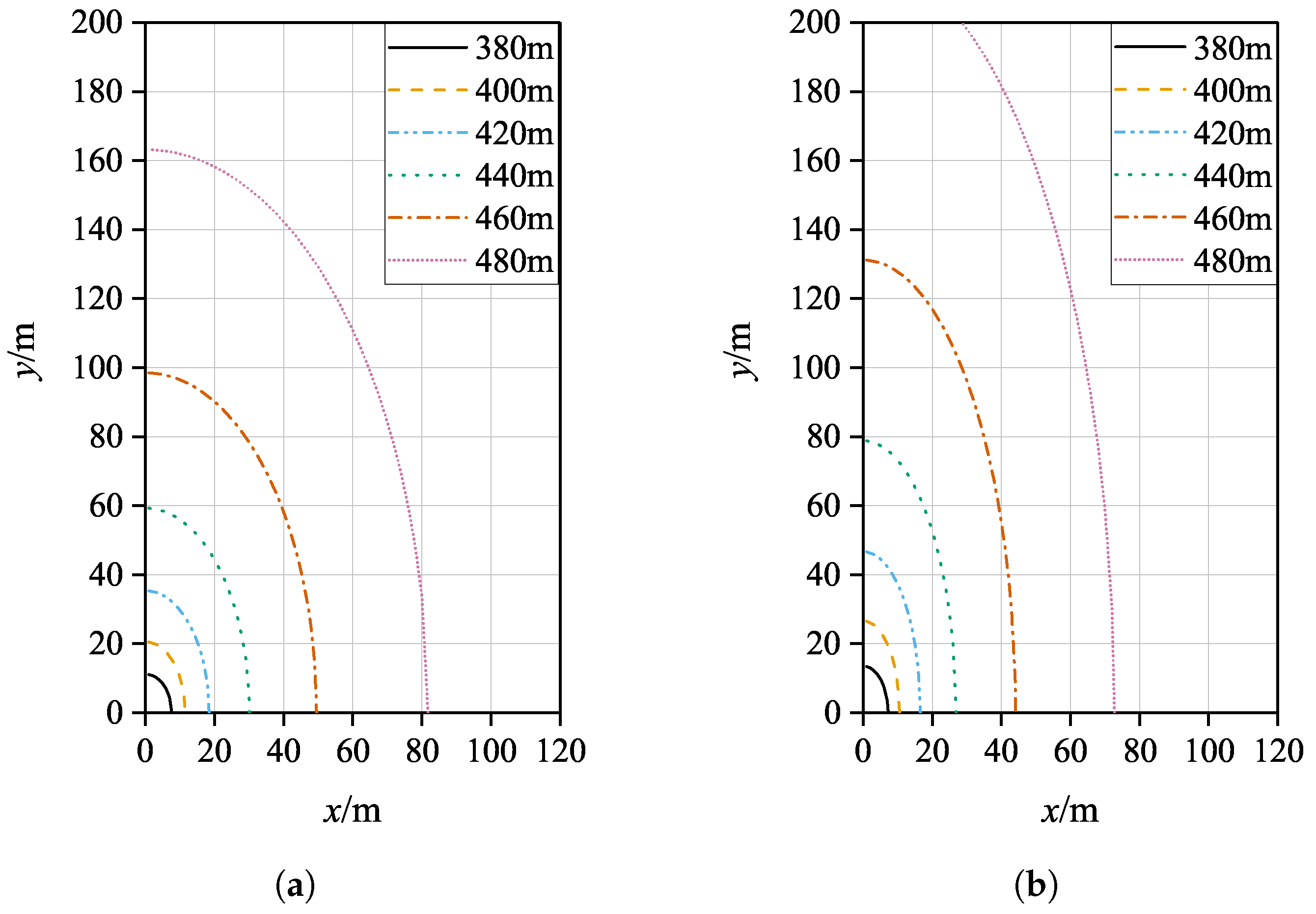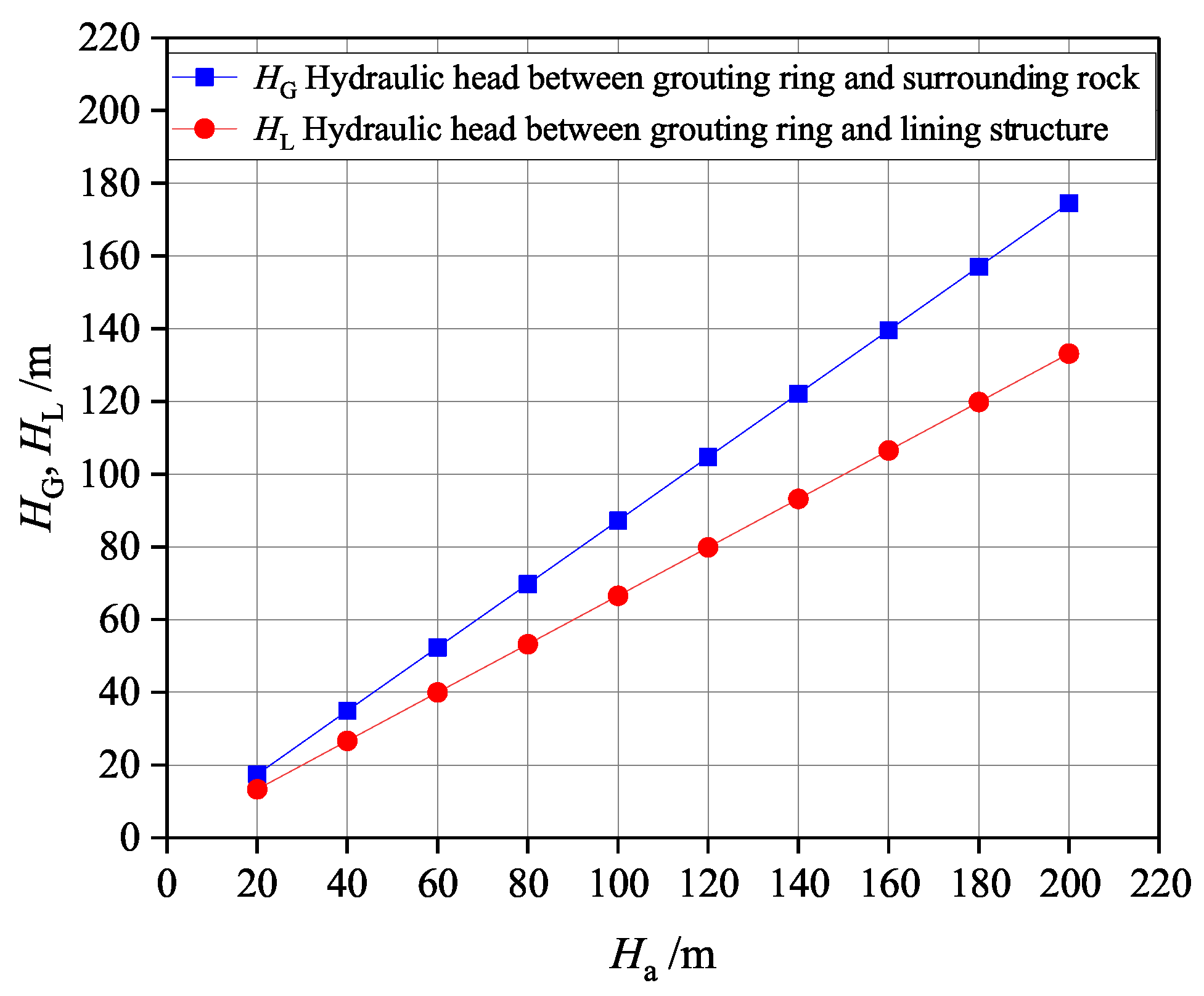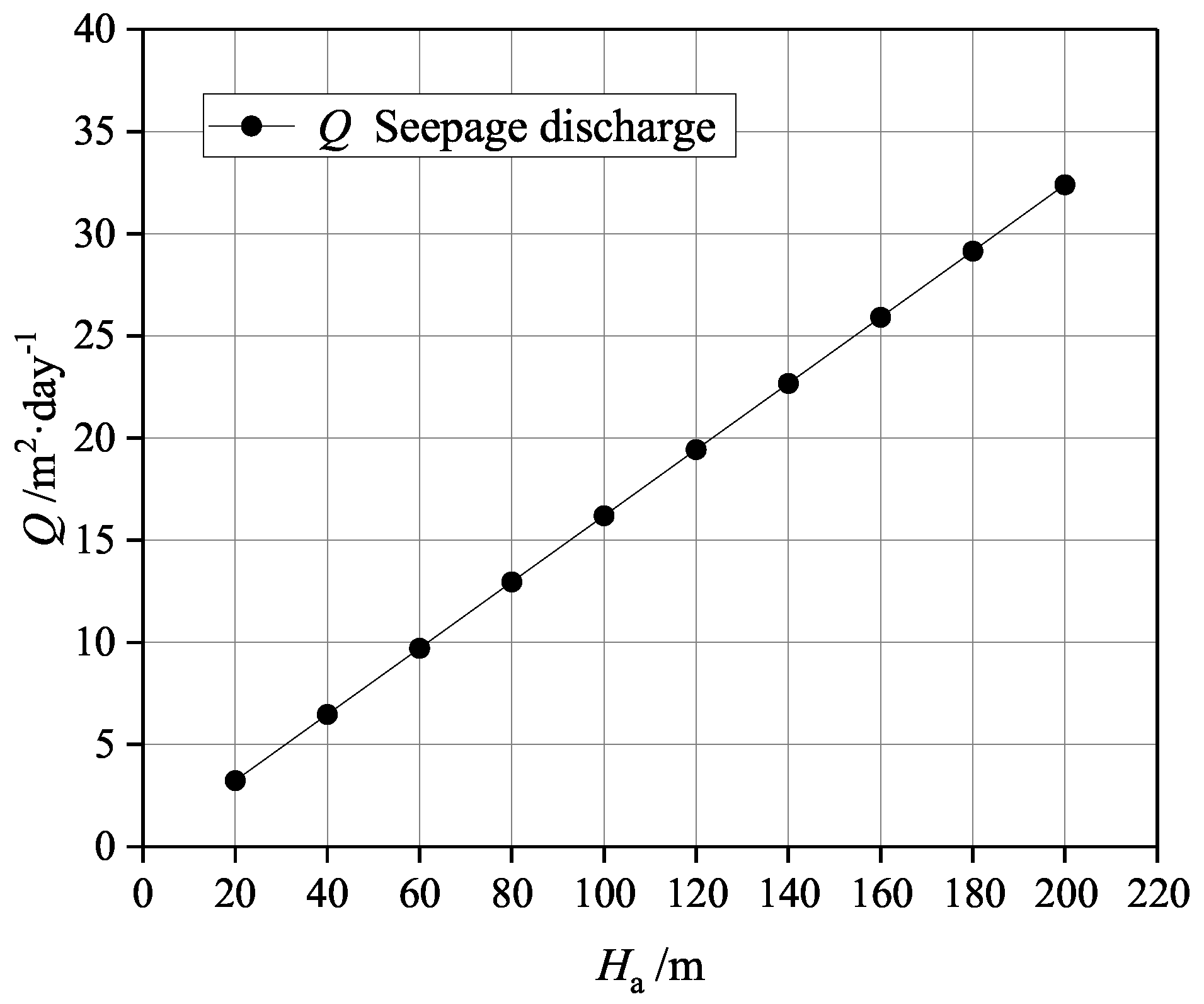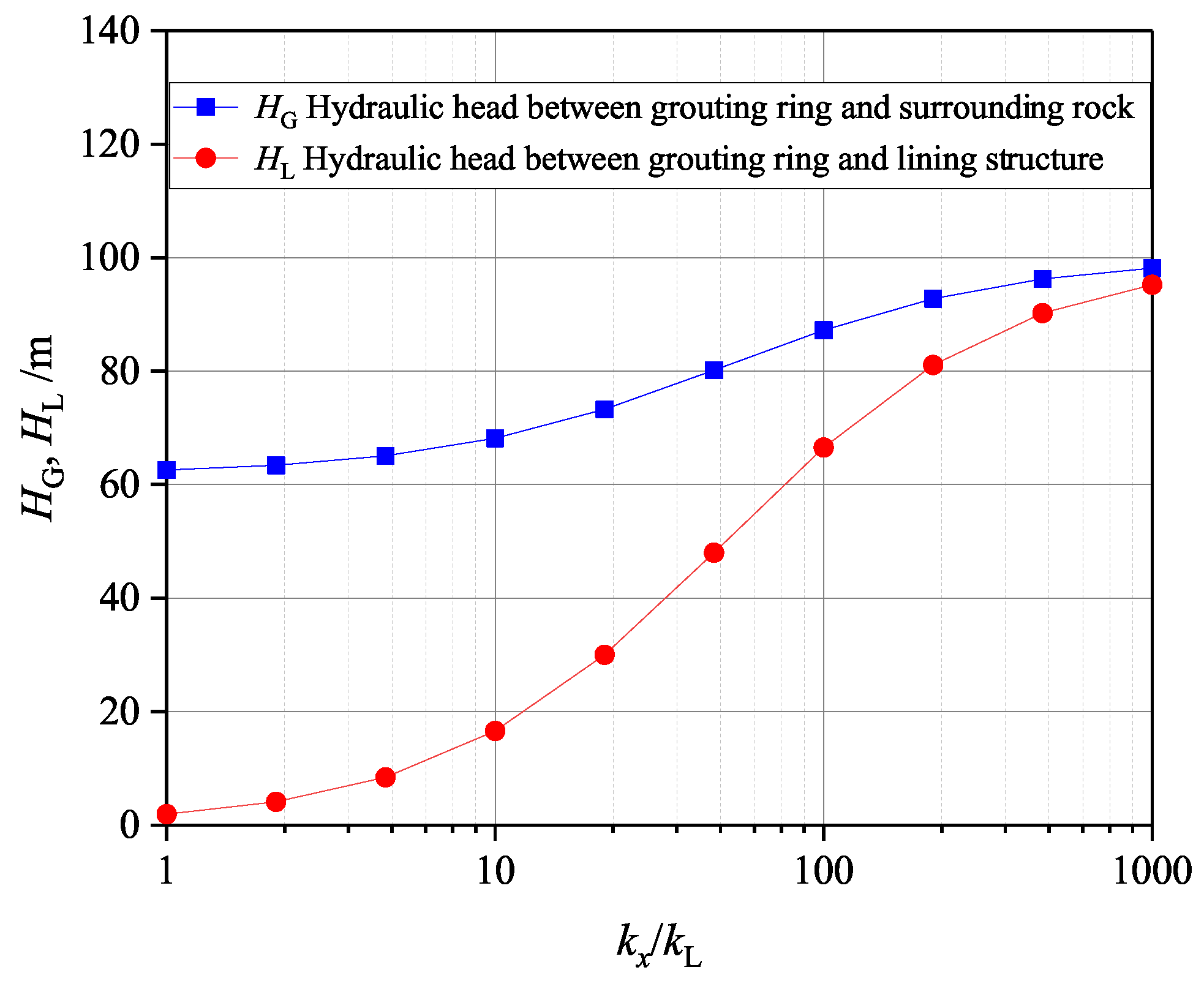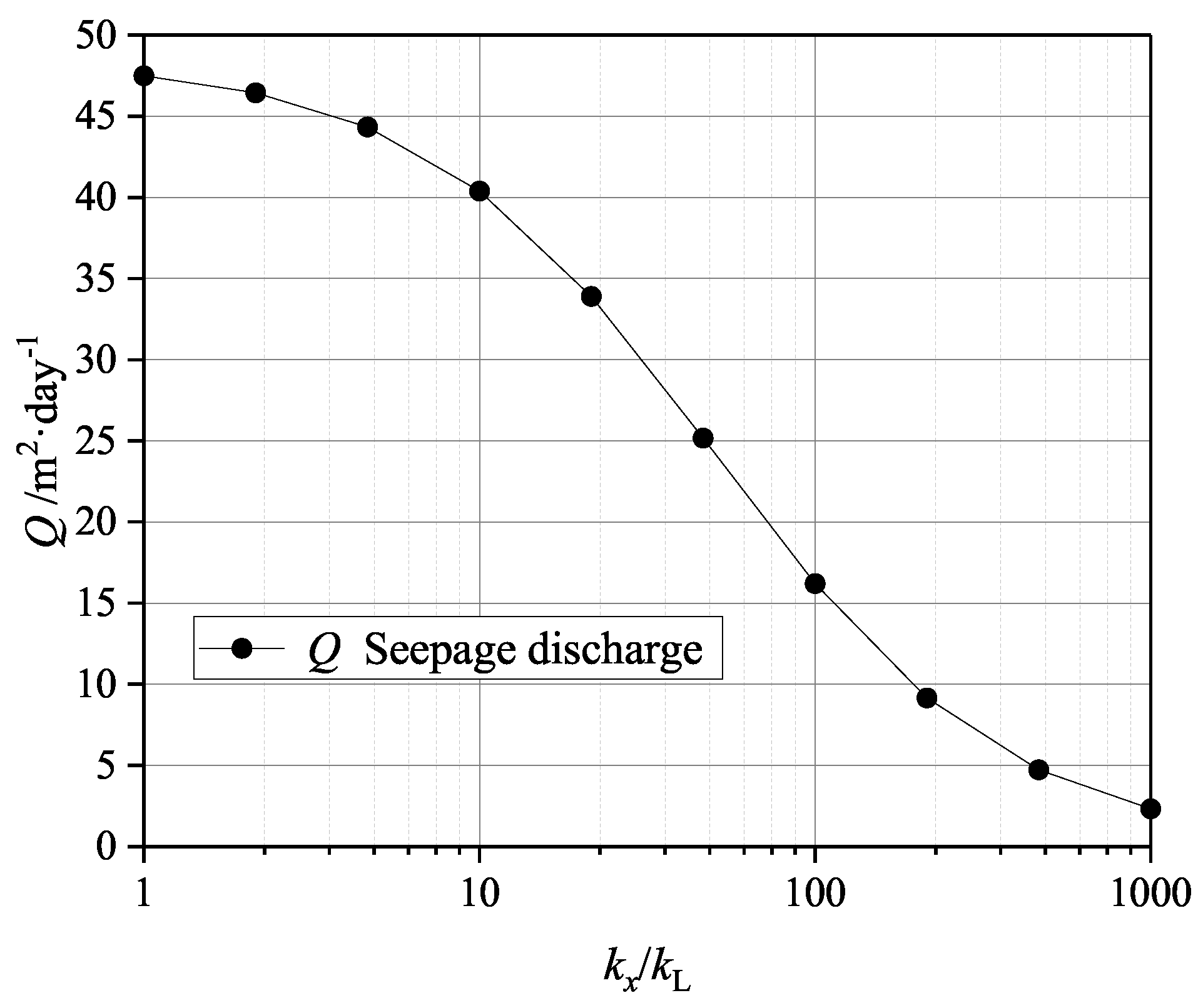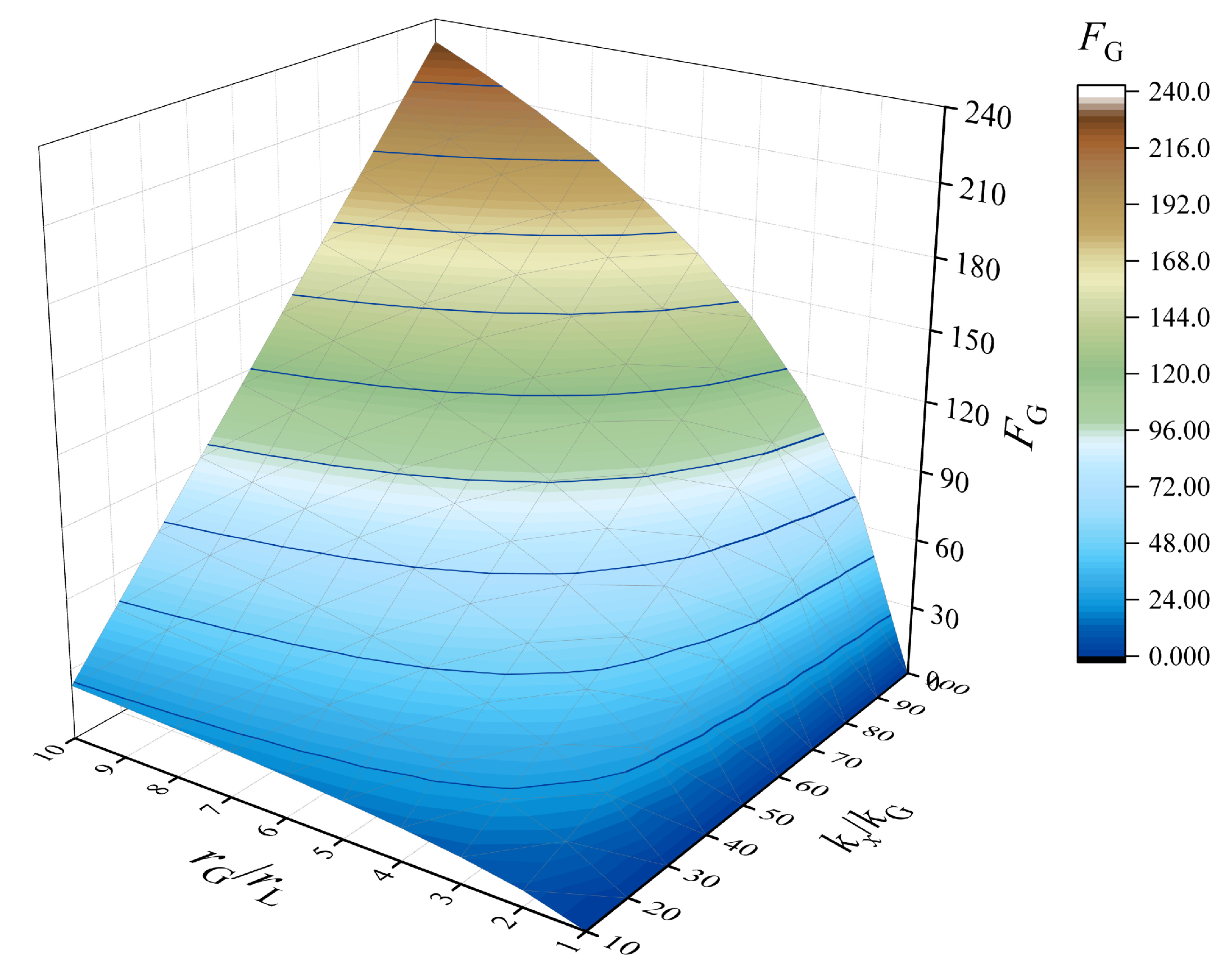1. Introduction
With the development of China’s economy and society, tunnels play an important role in the national economy and people’s daily life and travel. However, there are still many difficulties in tunnel design and construction, especially in tunnels in water-rich strata, mountain tunnels with high water level and sub-sea tunnels. The existence of a seepage field makes the working conditions faced by tunnel construction and operation more complex, and the existence of seepage field increases the potential safety hazards during construction and operation [
1]. Therefore, studying the distribution law of a tunnel seepage field can provide necessary reference for design and construction.
The research on the seepage field of an underwater tunnel has always been a hot topic. Based on some assumptions and simplified models, the seepage field can be quickly obtained by an analytical solution, in which the key parameters can be analyzed. The mirror image method [
2,
3,
4,
5] and conformal mapping in the complex variable method [
6,
7] were mainly employed analytical studies for the seepage field of underwater tunnels. Lei [
8] derived an analytical solution for calculating the seepage field and water inflow of a circular tunnel based on the mirror image method. Tani [
9] obtained the seepage field around an underwater shallow tunnel using the conformal mapping method for a circular tunnel. Wu et al. [
10] established a combined analytical–numerical method to estimate the groundwater inflow into circular tunnels in drained conditions. Guo et al. [
11] proposed an exact analytical solution of a seepage field for underwater multiple tunnel problems using the Schwartz alternating method combined with conformal mapping. Luo et al. [
12] established a simplified steady-state seepage model for a deep buried tunnel and parallel adit, and the model was solved iteratively using the complex variable method and the Schwartz alternating method. Ying et al. [
13] presented an analytical solution for the hydraulic head that considers the effects of the seabed thickness and lining layers using conformal mapping and the principle of superposition.
The above studies have laid an important theoretical foundation for the design and construction of underwater tunnels. Because of the complexity when solving the seepage field of a tunnel, most existing analytical studies simplified the soil layer into saturated homogeneous and isotropic porous material. However, due to the different arrangement of soil particles in the process of natural deposition, the seepage in natural soil often presents anisotropy in engineering [
14]. Zienkiewicz et al. [
15] studied the orthotropic anisotropic seepage problem in a two-dimensional inhomogeneous medium using numerical approaches. Hu et al. [
16] presents a general solution for active earth pressure acting on a vertical retaining wall with a drainage system along the soil–structure interface considering an anisotropic seepage effect. Xu et al. [
17] proposed analytical solutions on a steady seepage field of deep buried circular tunnel considering anisotropic flow. Tang et al. [
18] proposed an analytical solution for groundwater flow through a circular tunnel in anisotropic soils based on conformal mapping. Luo et al. [
19] proposed an analytical solution of external water pressure on a deep tunnel lining in two types of horizontally layered hydrogeological structures. It can be seen that some existing research approaches are numerical simulations, and the influence of a grouting ring has not been considered in the existing tunnel anisotropic seepage field research.
This study proposes analytical solutions of a steady seepage field for a deep-buried tunnel with grouting ring considering anisotropic flow. The seepage field of surrounding rocks is solved by coordinate transformation and conformal mapping methods. The seepage fields of the grouting ring and lining structure are solved by boundary conditions and continuous flow conditions between them. The analytical solution for the seepage filed is verified with numerical simulation results. Additionally, the effects of total hydraulic head, permeability coefficient of lining structure and grouting ring, and grouting influence factors are discussed.
3. Verification of Analytical Solution of Seepage Field
Li et al. [
25] proposed an analytical solution for the isotropic seepage field of a deep buried circular tunnel without lining structure and grouting ring as follows:
Corresponding to the solution in this paper, when there is no lining structure and grouting ring, there is:
Because the seepage filed is simplified as isotropic, there is
n = 1. Equation (
16) can be simplified as follows:
Subscribing Equation (
46) into Equation (
24) yields:
is assumed as the semi major axis length of the ellipse in
z-plane, which the circle
corresponded in the
–plane. According to Equation (
16), the semi major axis of the ellipse in
z-plane is as follows:
Subscribing
n = 1 and
m = 0 into Equation (
48) yields:
Subscribing Equations (
45) and (
49) into the Equation (
47), it can be found that the simplified proposed solution is identical with that proposed by Li et al. [
25], which proves the correctness of the solution to some extent.
In order to further verify the correctness of the solution, an example comparison with numerical method is carried out. Finite element limit analysis software OptumG2 (Krabbenhoft et al. [
26]) is used for numerical calculation of seepage field. Considering the symmetry of the calculation model, a quarter model is used to simulate the seepage field as shown in
Figure 3a. The left and lower surrounding rock boundaries of the calculation model are set as impermeable boundaries with normal restraint. As it is a deep buried tunnel, uniform distributed total hydraulic heads are set along the outer boundary of the surrounding rock and the inner lining structure of the tunnel. The parameters used in numerical simulation are shown in
Table 1. OptumG2 uses adaptive meshing method in the calculation, and the meshing is shown in
Figure 3b.
From the derivation process of the solution in this paper, a specific value of
which meet the accuracy of general engineering is needed to obtain the seepage field. Li et al. [
25] took
and Li et al. [
27] took
in their research respectively. In the following calculation in this paper,
is adopted for calculation.
The results of the total hydraulic head by numerical simulation under different permeability coefficient ratio are shown in
Figure 4. It can be seen from
Figure 4a that the total hydraulic head contour of surrounding rock is circular when the permeability coefficients of surrounding rock in horizontal and vertical direction are the same, which means the seepage of surrounding rock is isotropic. When anisotropic seepage flow happens in surrounding rock around the deep buried tunnel, the total hydraulic head contour of surrounding rock is no longer uniformly circular distribution but elliptical distribution as shown in
Figure 4b,c. The hydraulic gradient along
y-axis which have a higher permeability coefficient is relatively smaller than that along the
x-axis.
The results of total hydraulic head along coordinate axis calculated by numerical simulation and the proposed analytical solution are shown in
Figure 5. It can be seen form
Figure 5 that the results calculated by the proposed analytical solution are in agreement with those calculated by numerical simulation, which can verify the correctness of the proposed analytical solution in this paper.
4. Parameter Analysis of Analytical Solution of Seepage Field
In order to further reveal the influence of anisotropy of permeability coefficient on seepage field of deep buried circular tunnel, the hydraulic head contour in surrounding rocks is calculated by proposed analytical solution. The parameters in
Table 1 are used for the calculation, and a quarter of the calculation area is taken. The results are shown in
Figure 6. Anisotropic seepage occurs when the permeability coefficient is anisotropic. The seepage field of surrounding rock around the buried circular tunnel is no longer uniformly distributed and presents elliptical distribution. Different head contour shapes occur with different permeability ratios of surrounding rocks. The hydraulic gradient is larger in the direction with smaller permeability coefficient, which is about n times of the direction with larger permeability coefficient.
The hydraulic head and seepage discharge between grouting ring and lining structure, and between grouting ring and surrounding rock are analyzed in following examples. The calculation parameters in examples are shown in
Table 2.
Figure 7 shows the hydraulic head between grouting ring and lining structure, and between grouting ring and surrounding rock under different total hydraulic head at infinite distance. The permeability coefficient of lining structure in this example is
m·s
.
Figure 8 shows the seepage discharge under different total hydraulic head at infinite distance. It can be seen from the results that the hydraulic head of grouting ring and lining structure and the seepage discharge increase linearly with the increase of the total hydraulic head at infinite distance. Obviously, it can also be seen from Equations (
30), (
35) and (
36) that the hydraulic head and seepage discharge have a linear relationship with the total hydraulic head at a very far distance when other parameters remain the same.
The following example will analyze the influence of the permeability coefficient of the lining structure on the hydraulic head and seepage discharge. The total hydraulic head at a large distance in this example is 100 m, and other calculation parameters are shown in
Table 2.
Figure 9 shows the hydraulic head of grouting ring and lining structure under a different permeability coefficient of lining structure. It can be found that with the decrease of the permeability coefficient of the lining structure, the hydraulic heads of the lining structure and the grouting ring are increased. When the difference between the permeability coefficient of the lining structure and surrounding rock is not large (e.g.,
), the change of the permeability coefficient of the lining structure has a great impact on the hydraulic head. However, when the permeability coefficient of lining structure differs greatly from that of surrounding rock (e.g.,
), the influence of the permeability coefficient of lining structure on hydraulic head is no longer significant. Because when the permeability coefficient differs greatly, the lining structure can be considered as impermeable, so the hydraulic head of lining structure will be close to the total hydraulic head at infinity.
Figure 10 shows the seepage discharge under different permeability coefficient of lining structure. It can also be seen that when the difference of permeability coefficient is small (e.g.,
), the decrease of lining structure permeability coefficient greatly reduces the seepage discharge. However, when the difference of permeability coefficient is large (e.g.,
), the decrease of lining permeability coefficient has little impact on the seepage discharge, and the seepage discharge tends to be zero.
Wang [
28] and Liu et al. [
29] pointed out that the water shall be blocked by grouting ring for deep buried tunnels with hydraulic head greater than 60 m. Wang et al. [
21] studied water pressure distribution on tunnel lining and the results indicated that the grouting ring effectively reduced the water pressure on tunnel lining. Seikan tunnel in Japan and Yuanliangshan tunnel in China both adopt this method (Zhang [
30]).
Grouting ring is widely used as water plugging method in subsea tunnel. It is important to determine the influence of grouting ring parameters on hydraulic head and seepage discharge for the design of subsea tunnel. According to Equation (
7), the internal hydraulic head of lining structure is 0, Equations (
31) and (
36) can be written as follows:
Pan et al. [
23] proposed an influence factor for grouting parameters. With reference to this influence factor, the grouting influence factor is defined as follows:
where is
the ratio of permeability coefficient between surrounding rock and grouting ring, which reflects the impermeability of the grouting ring.
is the ratio of the grouting circle radius to the tunnel outer diameter, reflecting the size of the grouting ring.
According to Equations (
50) and (
51), when other parameters are determined, the hydraulic head of the lining structure and seepage discharge will be determined by the grouting influence factor. The larger the grouting influence factor is, the smaller the hydraulic head of lining structure is, and the smaller the seepage discharge is.
The variation of grouting influence factor with
and
is shown in
Figure 11. It can be seen from the results in the diagram that the grouting influence factor shows a linear growth trend with the increase of
and a logarithmic growth trend with the increase of
. The size of the grouting ring has a more significant effect on the grouting influence factor. In practical engineering, the adjustment range of grouting ring permeability is larger than that of grouting ring size for economic reasons. Therefore, in engineering design, the minimum value of permeability of grouting ring, i.e., the maximum value of
can be determined first, and then the grouting ring size can be determined on this basis.
5. Conclusions
Based on the existing theoretical research of the tunnel seepage flow field for a deep-buried tunnel, analytical solutions of the steady seepage field for a deep-buried tunnel with grouting ring are proposed considering different permeability coefficients of surrounding rocks in horizontal and vertical directions i.e., the anisotropic seepage flow and considering the influence of tunnel lining structure and grouting ring. Through coordinate transformation and conformal mapping, the seepage field of surrounding rock is solved. Then the seepage fields of surrounding rock, grouting ring and lining structure are solved by boundary conditions and continuous flow conditions between them. Verification analysis and parameter analysis are carried out, several conclusions can be drawn as follows:
(1) The analytical solution of the anisotropic seepage field of surrounding rock proposed in this paper is completely consistent with the analytical solution of isotropic seepage field in the case of simplification, which proves the correctness of the solution in this paper to some extent.
(2) For the anisotropic seepage field of a deep buried tunnel with grouting ring, the calculation results of the analytical solution in this paper are completely consistent with the calculation results of the finite element limit analysis software OptumG2, which can verify the correctness of the solution in this paper.
(3) The seepage field of surrounding rocks around a deep buried circular tunnel is no longer uniformly distributed and presents elliptical distribution, after considering anisotropic seepage flow. Under different permeability coefficient ratios of surrounding rocks, different results of the hydraulic head contour are presented. In the direction of a smaller permeability coefficient, the hydraulic gradient is larger.
(4) As the permeability coefficient of a lining structure decreases, the hydraulic head of the lining structure and grouting ring are increased. When the difference between permeability coefficient of lining structure and surrounding rock is not very large, the change of permeability coefficient of lining structure has a great influence on the hydraulic head. However, when the permeability coefficient of the lining structure differs greatly from that of the surrounding rock, the change of the permeability coefficient of lining structure has no significant effect on the hydraulic head.
(5) The parameters of grouting ring are analyzed by using the grouting influence factors. The results show that the size of grouting ring has more significant influence on the grouting effect.
